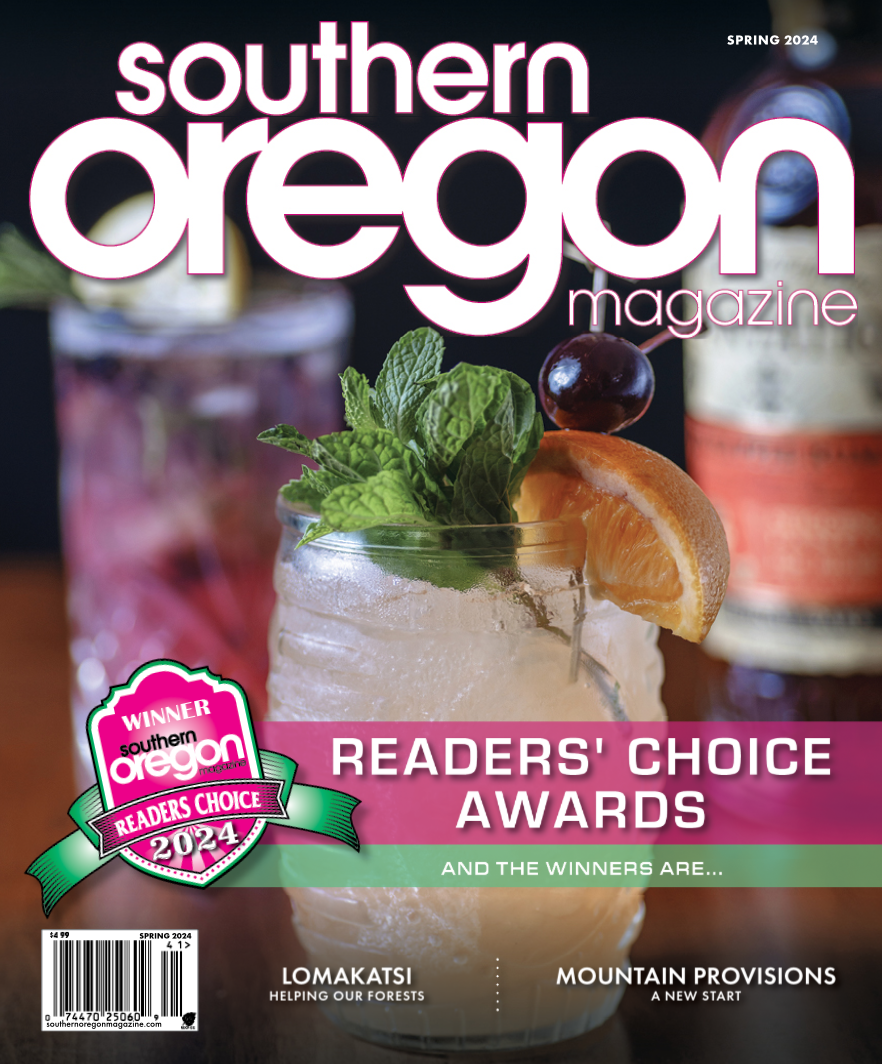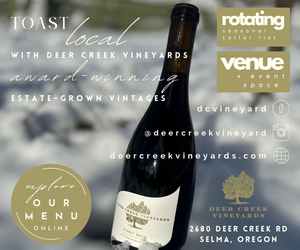

 Spring '24 Issue - Best Of Winners Announced & More
Spring '24 Issue - Best Of Winners Announced & More 
Sunday, October 9, 2016
The impact of the wine industry on employment in Southern Oregon
Many Hands Transform Dreams Into Bottles
The impact of the wine industry on employment in Southern Oregon
Story by Lynn Leissler
Southern Oregon’s wide range of microclimates and varied soil types have proven ideal for the burgeoning wine industry. Peeking behind the scenes at some of the less thought-about jobs that play a part in the process is more than worth it, allowing you to see the ever-growing wine scene impacting employment in Southern Oregon. We hope you will come away with a deeper appreciation for your next glass of wine.
In Southern Oregon, it’s commonplace to see hillsides rich in vines where numerous people consider wine tasting a regular outing. Many hands join in the journey from the dream to the bottle. The process involves farming, processing the grapes, and bottling the wine, while marketing and distribution get the word and the product to the customer.
Over the past decade, the wine industry has exploded. According to a 2015 Full Glass Research report, “The sum of all economic activity in Oregon related directly or indirectly to wine is around $3.35 billion. The net economic contribution, a measure of value added, is $1.4 billion.” Those numbers have risen even higher over the past twelve plus months.
The report delivers staggering figures brought in through wine-related tourism, activities, and licensing. Interestingly, the report also cites an estimated $11.3 million given annually to charities––a lot of money from the humble grape. While these statistics cover the whole state, Southern Oregon is rapidly making inroads as a major player and gaining a reputation outside our borders.
As this awareness grows, folks from out of state and other countries, who once flew into Portland and meandered through wine country as far south as Eugene, are now extending their trips to explore Southern Oregon wine trails and flying out of Medford. Tour companies offer package deals featuring wineries, an event or play, and lodging. Some tours focus exclusively on wineries. Wine-related events also draw large crowds, many coming from outside the region. These out-of-town visitors need places to eat and sleep, thus boosting the local economy through infused dollars and hospitality-related employment.
But first, the dream. Some individuals or couples already lived here and saw an opportunity to be part of the industry in its initial growth stages. Others researched the industry and were impressed with the climate and opportunity to grow grapes that aren’t possible in other parts of Oregon.
About ten years ago, Scott and Kris Steingraber were purchasing grapes to make wine in their Gig Harbor, Washington garage. Any time Scott came across a wine he liked, he found where the grapes came from, knowing a good glass of wine showcases the quality of the grape. He soon discovered Southern Oregon grapes. He tested the soil on land his wife, her brother, and their parents owned in the upper Rogue region. “We fell in love with the wine first,” Scott says. “The land came next, and our business came third.” The business is Kriselle Cellars, and their story is only one of many about people drawn to the region for its soil, climate, and livability.
After the dream, the hard work begins. First, the new entrepreneur must research and consult experts about soil quality, procedures, and site selection. Many colleges, including Southern Oregon University and Umpqua Community College, offer courses related to growing grapes, making wine, and marketing. The wine grape farmer needs to prepare the ground before planting a vineyard. Oregon Vineyard Supply, dealing with vineyards but not wineries, sells needed materials, such as wood and steel posts, wire, deer fence, and hardware. Once there is a crop, OVS supplies chemicals and fertilizers, emphasizing environmentally healthy farming methods. Brian Wolf of OVS says his company offers more than just a physical product. As a pest control advisor and one of the few licensed agronomists in the area, he is able to come alongside the farmer to answer questions and give counsel. “We feel we play an integral part in the industry,” he says.
The topography and soil make some acreage unsuitable for many crops, but ideal for wine grapes. DANCIN Vineyards is located outside of Jacksonville on land that wasn’t farmable due to lack of water and only grew weeds. After a long, complicated process, they secured irrigation and presently boast acres of vines. “Now it’s a farm, and the county likes that,” says owner Dan Marca.
Growing grapes requires dedicated workers to bring the crop to harvest. At the beginning of the year, the vines must be pruned. How well that’s done determines how the plants will perform throughout the year. Along the way the vines need thinning, and the soil needs to be tested and nutrients added, if necessary. Katherine Bryan of Deer Creek Vineyards and Winery says, “It’s a lot of work!”
The industry draws people from across the United States and from other countries, especially from Mexico. Wiebke Huntermark Rooney, who traveled from Germany to visit her sister, fell in love with Oregon and met her husband. After a time, she was single once more and sought work at Deer Creek as a picker. As John and Katherine Bryan observed her work ethic and willingness to learn, they called her back for pruning and soon asked her to be the vineyard manager. They have never regretted that decision. Wiebke says she loves what she does, noting that every single plant is different, and she tends them with that attitude. Harvest requires more workers if the vineyard handpicks its grapes. Many in the Hispanic community bring focused diligence to these jobs, and growers are grateful.
Many of those involved are relatively new to the industry and to the region. Others boast longevity, such as John Guerrero, who has been the winemaker at Valley View since 1985, possibly the longest standing person claiming that position. Consuela Holguin, Herb Quady’s mother-in-law, has managed Quady North’s vineyard for eleven years.
With tons of grapes literally ready to be made into wine, more talent is required. Cellar hands assist in the winery with transferring wine from tank to tank, keeping the tanks clean, and filling bottles. “And, of course, tasting,” says Jonathan Maldonado, who has been with Del Rio for over ten years, seven in the winery. Where once men dominated the business, women are finding their place as owners/partners, vineyard and winery managers, marketers, winemakers, and tasting room managers.
Not all vineyards have their own winery, but instead use the services of custom crush facilities, such as Barrel 42 and Naumes Crush to process their products. Pallet Wine Company, another custom crush, has opened a tasting bar next to its facility in Medford as a place to showcase its clients’ wines. The custom crush essentially becomes the winemaker, but works with clients in vineyard strategies. It becomes a collaborative effort to create a wine that suits the client’s taste and style. At the Oregon Wine Experience, Herb Quady’s Barrel 42 brought in over a dozen medals for its clients.
The region’s vineyards and wineries vary in size. Some are small by choice and learn to craft wines with selective hand picking, while others focus on mass production and run big-scale operations. Del Rio, one of the region’s largest wine grape growers, currently has 300 acres in production and looks to add another 465 acres next year. They employ 40 people in the vineyard and winery, adding more during peak times, such as pruning. 2Hawk recently completed an on-site winery of 14,000 feet under roof. Winemaker Kiley Evans, originally from Florida, says he helped design it and now he gets to play in it. This year, all the estate grapes will end up in 2016 wines.
Once the vintage is properly aged and bottled, perhaps even earning an award, it does the winery little good if people don’t know what’s available, which is when marketing comes in. Laurel Briggs, owner of Creative Marketing and Design, served her first wine client about five years ago with label work for Ledger David. As the industry grew, she moved into web design and e-commerce. Currently she assists with advertising and management of events, such as the summer’s Oregon Wine Experience.
Knowing wineries want to focus on what they do best, Mandy Valencia, owner of Warrior Media, steps in to offer her expertise in social media, a job that didn’t exist a few years ago. An online presence not only helps get the word out, but also provides data on viewer demographics. Valencia serves the Bear Creek Wine trail, helping them set up press releases, as well as recently overseeing the production of a short film featuring the winery.
Marketing Consultant of Capiche Communications Chris Cook, who worked with wine customers, found herself “amazed at the amount of detail that goes into a glass of wine.” After suggesting she should take wine courses to deepen her understanding, she enrolled at the Southern Oregon Wine Institute at Umpqua Community College. She, too, mentions winery owners’ lack the background for marketing, and many are too small to have an in-house consultant. Monthly she oversees a roundtable gathering of owners and tasting room managers to help them strategize and also facilitates networking.
A distributor is essential in getting the wine to the consumer. Though it’s easy to think of what they do as a stop-and-drop process, C. J. Johnson, owner, Summit Beverage offers wineries far more. Starting in a garage, they now operate out of a large warehouse in Phoenix. More and more restaurants, stores, and even growler stations feature Southern Oregon wines, so pickup from the supplier and delivery to a restaurant or store is part of what Summit does. In so doing, they see the larger picture, enabling them to offer counsel on pricing and observations on the market to be a liaison. Wine Director Erika Balbier (Summit handles other beverages as well) goes to tastings, events, and talks with folks in the business.
Southern Oregon wines are finding their way out of the state, even out of the country. Cliff Creek Cellars is in six other states. Del Rio is in 17 states, as well as Canada, China, and makes a private label for the Cayman Islands. Valley View wines can be found on shelves in 22 Costco stores in Japan. Quady North wines are in six states, plus the Netherlands, Germany, Denmark, and Sweden. The Southern Oregon wine industry is still young, but as it grows, some owners are reaching out to those with greater experience. 2Hawk hired Holly Andreson from Napa Valley as its retail and business development manager. She brings almost 19 years of experience to the business and sees things from a well-rounded vantage point, confident in Southern Oregon’s wine future.
The wine industry isn’t all about gain for itself, however. Many bottles and dollars are donated on behalf of charities. The 2016 Oregon Wine Experience, an event held in August, locally raised just shy of $750,000 for Children’s Miracle Network, which is just one of many charitable events in which wineries participate.
People love to go wine tasting, traveling to one or more wineries. They form their first impression of a winery at the entrance of the property, the second as they enter the tasting room. Jillian Garrett, wine club manager and tasting room employee at Folin Cellars, used the word “peopleology” to describe what she does. She says selling wine isn’t just about what’s in the bottle, but about the experience. A good wine poured by someone personable goes a long way toward a sale. Tasting room employees are often part time for various reasons. After her family’s Butte Creek Mill was destroyed in a 2016 Christmas day fire, Kristin Russell, needed employment. While she awaits the mill’s rebuilding, she pours at Agate Ridge Vineyard’s tasting room. Wine clubs are also important to the industry, getting product out, as well as spreading a winery’s reputation. RoxyAnn claims the largest in the valley, with over 1,500 members. Club members often take advantage of their discount to purchase gifts.
A number of wineries also serve food, employing people in the kitchen and as servers. DANCIN is one, with well over a dozen people working various shifts.
Events & Promotions
Apr
19
Apr
20
Apr
21
Jacksonville
David Pinsky & Phil Newton play Rellik winery
Dave Pinsky & Phil Newton play Rellik Winery
Apr
26
Apr
27












